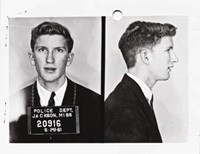
UC Clermont College Professor Fankhauser Featured in New Civil Rights Book - Breach of Peace
Almost forty years ago, college sophomore David Fankhauser found himself in the heart of the segregated South boarding a bus in Montgomery, Ala., heading towards Jackson, Miss. to demonstrate a civil injustice taking place.
Fankhauser and his fellow demonstrators, who called themselves Freedom Riders, risked their lives to raise awareness and challenge Southern transportation segregation laws. The Freedom Riders were champions of the U.S. Supreme Court ruling outlawing racial segregation of interstate travel.
Eric Etheridges recently released book Breach of Peace features police mug shots from 1961 and current portraits of more than 80 of the Freedom Riders and the mug shots of all 300-plus Riders arrested in Jackson that year. The demonstrators, who purposefully integrated bus station waiting rooms, were charged with breach of the peace and arrested. Fankhauser, who as a result, spent time in Jackson City Jail and Parchman State Penitentiary, is featured in the book.
We're very lucky to have this extraordinary visual record of the Freedom Rides -- a mug shot of every one of the Riders arrested in Jackson, Mississippi, in 1961. Here is a picture of the emergent civil rights movement. Here are the faces of the student-powered '60s. Here is history told at the individual level. When I first saw them, in 2004, I was immediately captivated by these images, and wanted to bring them to a wider audience. I wanted to find the Riders today, to look into their faces, to make new portraits to set against the earlier photographs, said Etheridge.
In the week before I went down, Freedom Riders had been viciously beaten and hospitalized in Anniston (where a bus was fire bombed), Birmingham and Montgomery. The ranks of Freedom Riders were decimated, the Rides in danger of collapse. Through a network of college student activists, the call went out across the U.S. for volunteers to come south and take the place of the injured Freedom Riders, said Fankhauser, a professor of chemistry and biology at the University of Cincinnati, Clermont College.
Further action is required to make this image accessible
One of the below criteria must be satisfied:
- Add image alt tag OR
- Mark image as decorative
The image will not display on the live site until the issue above is resolved.
Fankhauser had long been committed to the principle of equal rights for all people in society - regardless of race, gender or religion. Clearly the law of the land outlawing segregation in interstate travel was being violated in the South. The federal government turned a blind eye to this injustice. It was, if you excuse the expression, a matter of black and white, especially to an idealistic 19-year-old, said Fankhauser.
The Freedom Riders were the catalyst that moved the Kennedy Administration to step in and enforce the Supreme Court ruling.
Although the Kennedy administration was in favor of equal rights in theory, they were loath to do anything which would offend Southern Democrats or Dixiecrats which might break up the Democratic coalition Finally, after representatives of the U.S. Attorney General were beaten up in the streets of Alabama and more than 100 Freedom Riders were jailed in Mississippi, the Kennedys moved to enforce the law of the land, Fankhauser added.
America was changed for the better by the grassroots democratic movement sparked by a few hundred (mostly) young people who were not crazy just brave and idealistic, with wills of their own and a passion for a fairer and more democratic America. They are true American heroes, said Roger Wilkins in his preface to the book.
Tags
Related Stories
UC's record graduating class prepares for next chapter
April 22, 2024
UC will confer degrees to 7,521 degrees to 7,391 students. (Some students are earning multiple degrees.) Both represent new records at UC for a single graduating class dating back two centuries.
UC Clermont to host Rapid Application Events
April 16, 2024
The University of Cincinnati Clermont College will hold four free Rapid Application Events on campus during May and June.
UC President Neville Pinto shares 2024 State of the University...
April 16, 2024
University of Cincinnati President Neville G. Pinto shared his 2024 Sate of the University address with the campus community on April 15.
